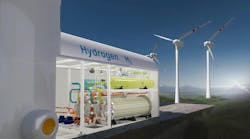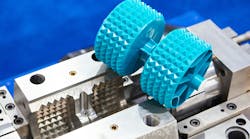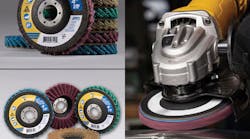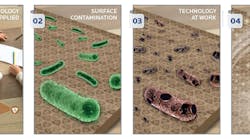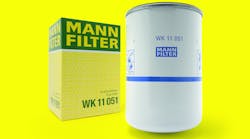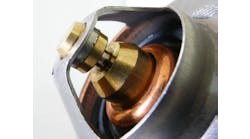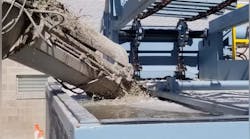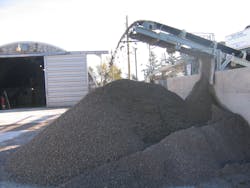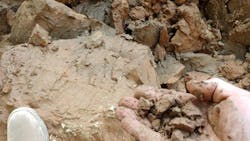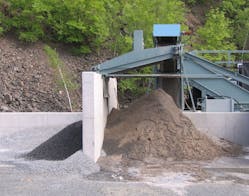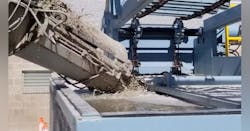The challenge is that traditional washout techniques can be time-consuming and labor-intensive, often involving multiple steps. As a solution, industry innovators have created systems that dramatically streamline the washout process, which saves considerable time, labor, and money. These systems can recover sand, stone, and cement for resale or reuse, using recycled water in a closed-loop system.
The most advanced units allow a driver to complete a washout in minutes at a single onsite location without a washout pit, settling pond or presses of any sort. This keeps concrete trucks on the road making money, instead of wasting time on slow washouts.
“Altogether we are saving hundreds of thousands of dollars a year in driver’s time, truck time, and trucking material using a modern washout system,” says Frank Gelewski, Director of Operations at Fair Lawn, NJ-based Tanis Concrete, Inc., which services major highways, airports, and other state and municipal work throughout Northern New Jersey with three state-of-the-art concrete plants.
“Our water usage is also way down because we are reusing it. We are not wasting water to wash out the trucks only to have it evaporate or hydrate into the ground.”
Costly, Inefficient Waste Material Handling
For ready-mixed operations, the process of washing out concrete trucks and equipment is essential to reclaim unused material. It also prevents buildup on the equipment and makes meeting mix specifications easier. However, the typical practices employed are inefficient, as they involve multiple processing and material handling steps.
The washout process typically involves using designated pits designed to receive washout water and material. Operators rinse and clean the concrete trucks and equipment using high-pressure water, allowing the excess concrete to wash into the pit. Once the concrete washout has settled to the bottom, the solid material can be removed and disposed of properly. Similarly, settling ponds allow suspended cementitious solids in washout wastewater to settle before further processing or disposal.
In the case of Tanis Concrete, the original process of getting washout water was slow.
A concrete truck driver would take the vehicle to the plant water supply to fill tanks with water used to rinse out its mixing barrels. The operator would then drive to a washout pit and discharge the water and leftover materials into the pit.
Another concrete reclamation method, called concrete curing, involves spreading the leftover concrete on the ground. Once the concrete has dried and hardened to a certain extent, it is typically broken into manageable pieces using heavy machinery or equipment. Crushing machines then process the broken concrete pieces further for use as recycled aggregate. This material can sometimes be used as a substitute for natural aggregates in new concrete mixes or other construction applications.
In all these conventional methods of concrete reclamation, any travel to washout pits, settling ponds or concrete curing sites is time that truck drivers are not making deliveries. The extra material handling steps slow the process, increase labor costs, add to equipment wear and tear, and reduce the plant’s profitability.
In washout ponds and pits, the cost to replace make-up water, which is often purchased from a local utility or pumped from wells, can also add up quickly. The ponds and pits usually require continual maintenance to remain functional. Ponds typically need continual sludge cleanup. As pits fill with washout material, they need to be excavated and carted away to a facility that charges for recycling. A messy job that coats equipment with cement and can cause serious maintenance headaches. Pond liners also can become torn and require additional maintenance to repair.
“About every three months we had to excavate the pit [of washout material], put it in a stockpile, and let it dry out. The material was mixed with clays, fines, stone, and hydrated cement. It was basically a useless product, so we had to pay to have it hauled away to a concrete recycling facility about 12 miles (19 km) away. At the time, it cost about $200 a load to dump the material, not counting the truck rental; today, it would cost about $500 a load,” says Gelewski.
According to Gelewski, the cost of water was also an issue. “We were using metered city water and had to pay for any wasted water. We were offering about 25 different concrete mixes, so the wasted water at the end of each quarter [when we paid our water bill] was excessive.”
In addition, he notes that space was constrained with the onsite pit and stockpiles since Tanis Concrete operated on a one-and-a-half-acre site.
Faster, More Efficient Washout
Rather than have concrete truck operators waste time driving to remote locations for washout, the machine is conveniently located at the plant. Concrete truck operators simply drive up, dump, and drive away. This one-stop approach allows for faster washing out of concrete trucks, which reduces downtime and increases productivity. The cumulative time savings across multiple drivers in an eight-hour workday can be substantial.
As an example, the Redi-Wash Washout System by Jadair does not require settling ponds, washout pits or filter presses since it has a built-in water clarification capability, unlike traditional reclamation-only units.
Port Washington, WI-based Jadair International, Inc. is a provider of various solutions for the concrete industry including concrete reclaimers and water clarifiers. The company manufactures equipment for mobile and permanent installations in many sizes and configurations, and works with ready-mixed, precast, and other concrete producers.
The washout system provides concrete reclamation and water handling within one self-contained, closed-loop unit. The machine separates and discharges the sand and stone, which enables complete recovery of these items. Sand is not washed out of the aggregate. Spent cement is discharged separately and a loader can handle this cement easily as a dry, clay-like product. The water is directed into a separate area of the machine where it is clarified and reused for washouts.
To perform a washout, the driver simply backs up the concrete truck to the machine. The machine adds recycled water to the truck’s rotating cylinder, which mixes the water with any remaining concrete for a couple of minutes. The truck then dumps the washout water and concrete into the machine, which processes and reclaims it.
After searching for a solution, Tanis Concrete installed a three-station, Jadair Redi-Wash Washout System that accommodates three trucks at the same time over a decade ago. The company space efficiently located the system in their onsite truck garage by converting a service bay.
“The water is right there at the washout system. There is no running back and forth from one site to another, so we are saving a significant amount of time compared to the previous washout pit,” says Gelewski.
One unique aspect of this approach is that there is no need to “dribble” or “slowly meter” the washout material into the machine. The system is designed to take in 8 yds3 (1,600 gallons) in four minutes or less.
The one-stop approach saves money by eliminating long-distance drives and slow process times. With high-speed washouts, the concrete plant can run fewer trucks with less labor and material handling while still delivering the same amount of material or more.
“Now, we no longer need to have a washout pit or a pile of excess material on the side that we have to pay to truck out,” says Gelewski.
Instead, according to Gelewski, the washout system provides excellent separation, so Tanis Concrete can sell material that it previously paid to haul away.
“The system separates the clays and cements from the sand and gravel. We could have screened out the 3/4, 3/8 inch stone from the sand and reintroduced it into our mixes, but choose to sell the material,” says Gelewski.
Since the machine recycles the water, this approach eliminates the cost of replacing makeup water in ponds and pits, which lose water constantly due to seepage and evaporation. There is also no pond sludge to clean up and no pit to excavate and maintain.
“Our washout system reuses the water, so our water usage costs went way down,” says Gelewski. He notes that this capability also helps to prepare the company for a future of potentially greater regulatory scrutiny of water use.
The approach also saves concrete plants a considerable amount of space since one compact unit accomplishes the truck washout. Without settling ponds or pits, the plant can use the space more productively as storage for concrete products and inventory or other needed applications.
To help concrete plant executives calculate the potential savings of the streamlined approach, Jadair offers a savings estimator that evaluates factors, such as the cost of material, labor, and truck operation. By inputting these variables along with the number of hours the plant operates per day, the estimator can provide a comparison of potential savings versus current methods.
For concrete plants where settling ponds or pits are still in use, the Jadair Redi-Claim System works similarly as an efficient washout material reclamation solution because it can still separate sand, aggregates, and cement. However, this system directs washout water to the plant’s existing settling ponds or pits to be clarified.
Although washout pits and ponds are common, concrete producers that take advantage of innovative options can streamline the washout process and boost their productivity. With the sophisticated systems available today, plants can now reclaim any leftover concrete materials faster with more profitably than ever before.
For more information, call (800) 669-3411 or visit www.jadair.com.
Del Williams is a technical writer based in Torrance, California.
